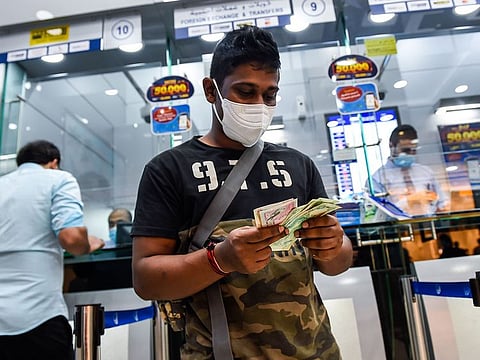UAE expats to remit more: Indian, Pakistani rupee, Philippine peso to get weaker this week
Higher prices of oil, gold likely to weaken currencies in India, Pakistan and Philippines

Dubai: The currencies in India and Pakistan are expected to weaken further this week, forex analysts evaluated, making it a more cost-effective time for the regions' expats in the UAE to remit more dirhams back home.
The value of the rupee in India and Pakistan are expected to weaken on the back of economic pressures from the ongoing hostilities between Russia and Ukraine. Higher prices of global crude oil and gold is likely to weaken the currencies in both countries as well.
Presently, India imports 85 per cent of its crude oil needs. Higher oil prices are expected to add Rs8 to Rs10 in petrol and diesel's domestic selling prices. Besides, the cascading effect of expensive fuel cost will trigger a general inflationary trend.
On last Friday, a rise in the US oil inventories along with the assurance of energy supply from Russia, doused international crude oil prices. Consequently, the price last Friday came down to $95 per barrel after the Russia-Ukraine war pushed oil prices to $105 per barrel.
Indian rupee turns volatile
"Rupee had been volatile and closed at 75.29 against dollar for the week. Higher crude and gold prices can keep it weak," said Sajal Gupta, head of forex and rates at India-based Edelweiss Securities.
"Domestic fuel price hike is expected post the assembly elections which would stroke inflation and this can weaken rupee further." Moreover, Gupta expects a range of Rs74.80 to Rs75.50 to $1 for the coming week. Last week, the currency pair (USD-INR) had closed at Rs75.2950 to a US dollar.
According to Gaurang Somaiya, a forex and bullion analyst at India-based Motilal Oswal Financial Services, the greenback has been subdued recently as tensions in Ukraine have increased and fueled speculation that the US central bank may be less aggressive in tightening policy at its March meeting.
Somaiya added that volatility will continue to remain elevated as more clarity will be needed on the ongoing tensions between Russia and Ukraine. In addition, key economic data such as third-quarter GDP numbers and trade balance figures will be keenly watched and better-than-expected data could restrict major weakness for the rupee.
Pakistan rupee to weaken this week
The Ukraine crisis is expected to weigh on the Pakistan currency as a large current account deficit, surging energy and oil prices, and volatility in financial markets will likely put the rupee under pressure this week, analysts noted.
Pakistan's current account deficit of $2.5 billion, which is at an all-time high, seems to be the prime worry amid high global oil and other commodity prices, forex analysts evaluated. When imports are growing at a faster pace than exports, this deficit is increasing Pakistan's dependence on foreign loans to meet its financial requirements.
In the previous week, the Pakistani rupee fell by 1.36 rupees or 0.77 per cent against the dollar, after starting the week on 175.75 per dollar and closed at 177.11 on Friday.
Forex investors are concerned about the increasing pressure on the balance of payments, despite the fact that the central bank has said there is enough financing available to fund the deficit and the foreign exchange reserves are also at a comfortable level.
This is why analysts note that the uncertainty related to the current account and the geopolitical tension will exert pressure on the rupee in the coming week. The crisis had brought in a surge in commodities, and the rise in oil and energy prices were going to translate into elevated inflation level, and with Ramadan around the corner, food prices will also surge.
Philippine peso to stay pressured
Overseas Filipino workers (OFWs) sending money home are getting a windfall as the Philippine peso slid late last week following a spike in oil prices on supply disruption fears triggered by Russia’s invasion of Ukrainian cities.
Based on data from the Bankers Association of the Philippines (BAP), the Philippine currency closed at Php51.34 versus $1 on Thursday, 24 centavos down from Wednesday’s close of Php51.10. The value fell as much as Php51.53 in the days that followed.
In January, the Philippine peso dropped beyond Php51 per dollar for the first time since April 2020 amid speculation the nation's trade deficit will widen as domestic demand improves.
Given the jitters from the Russia-Ukraine conflict, some day traders warn that there’s going to be a lot of down moments this week before things get better.
- with inputs from Agencies
Sign up for the Daily Briefing
Get the latest news and updates straight to your inbox



